AI Pricing: How Much Does AI Development Cost
AI development cost is the largest challenge. It is true that any business, particularly small and mid-sized ones, may find the cost of developing AI to be prohibitive. We’ll discover the cost of AI software development, what factors affect these figures, and, most exciting of all, how to lower these expenses.
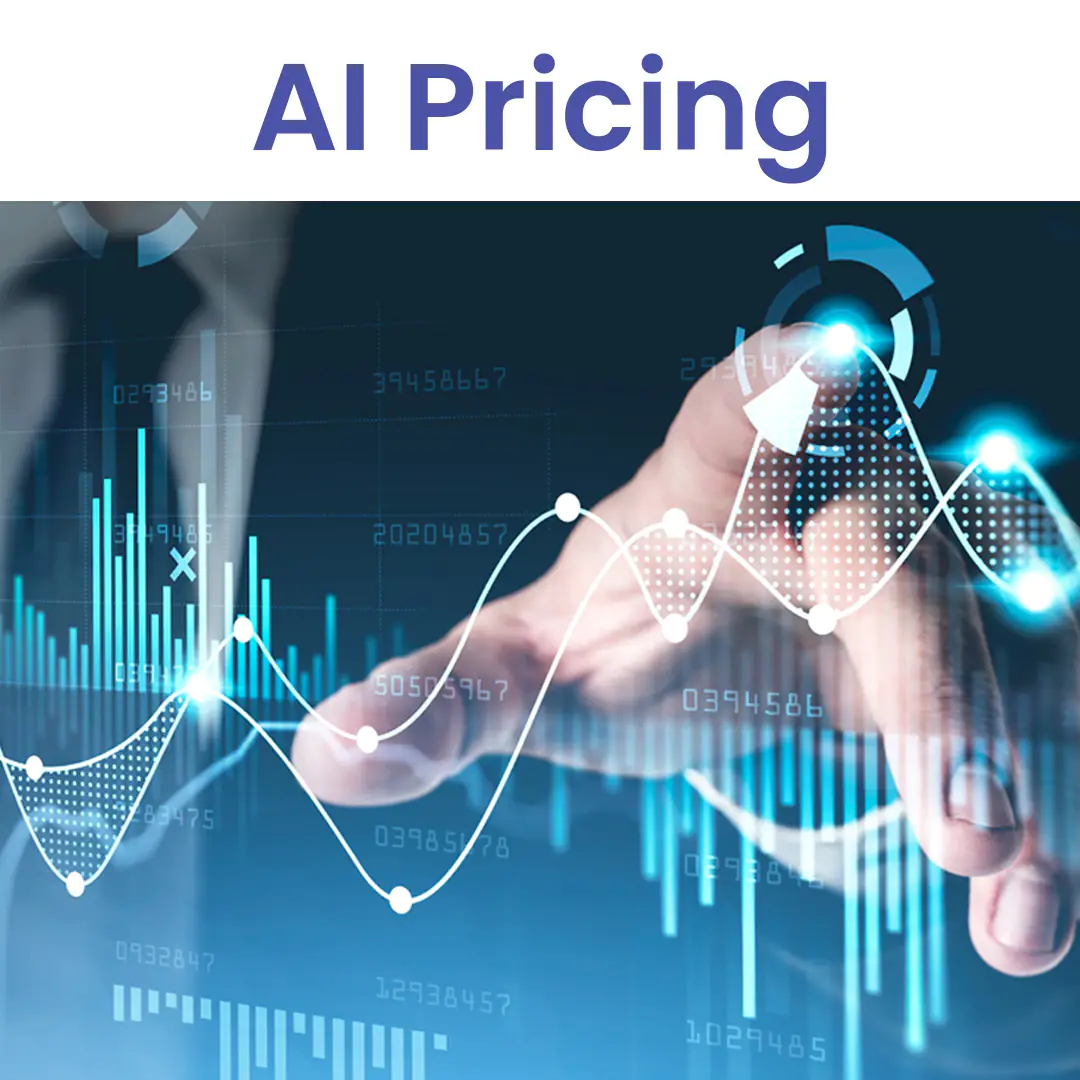
Ensure Regulatory Compliance and Mitigate Risk With AI-Powered Privacy, Security, and Audit Automation

“Organizations are beginning to take steps that drive bottom-line impact, for example, redesigning workflows as they deploy gen AI and putting senior leaders in critical roles, such as overseeing AI governance. The findings also show that organizations are working to mitigate a growing set of gen-AI-related risks and are hiring new AI-related roles while they retrain employees to participate in AI deployment. Companies with at least $500 million in annual revenue are changing more quickly than smaller organizations.”– McKinsey
How the Cost of AI Is Impacting Business Revenue
The need to show AI’s financial worth is growing along with its adoption. Several businesses have seen increased productivity, quicker decision-making, and new customer-facing capabilities because of their investments in AI. However, these benefits are frequently accompanied by increased infrastructure and software costs that reduce margins.
A growing disparity exists for some businesses between the cost of AI tools and their quantifiable effects. In the absence of adequate governance, teams can invest in models that never make it to production, employ overlapping tools, or underuse premium AI features. Because of this, AI cost insight is now essential for preserving income. Because of this, companies are using SaaS visibility and inventory management tools to restore control.
Is Your AI Worth the Investment? Try These Cost-Effective Testing Strategies
A more economical strategy could be to gradually explore AI’s potential before making a complete commitment. While controlling AI development costs, teams can produce high-quality, reasonably priced AI solutions by fostering a data-driven culture of creativity and cost consciousness.
- Scalability and lean methodologies in AI deployment save costs and reduce the need for significant rework as the project expands.
- Agile approaches, supported by effective AI algorithms, enhance cost control and result in AI projects by identifying and resolving problems early.
- Microservices design and the use of modular, reusable components reduce development expenses and time.
Businesses can validate their idea at an early stage of development by building a Proof of Concept (PoC) for an AI or ML product.
Balancing AI Development Cost with Business ROI
AI’s ROI varies based on how it is applied. Businesses that adopt a planned, centralized strategy are more likely to experience quantifiable benefits, whether in the form of:
- Better forecasting,
- Less manual labor, or
- Automation savings.
Nevertheless, dispersed spending, unused licenses, and exaggerated expenses that compromise ROI can result from decentralized adoption.
Many businesses are just beginning to track the ROI from AI. Determining which technologies are worth the investment is challenging without centralized monitoring. In this context, SaaS governance and risk mitigation are essential because they provide the framework required to oversee AI investments on a large scale.
What is the Cost of Not Adopting AI and Your Company’s Value?
Ignoring AI is no longer just a missed opportunity; it’s a strategic risk. From shrinking margins to talent loss, here are five critical consequences CEOs face when delaying AI adoption, along with the tangible business value they’re leaving behind.
- Revenue Loss from Missed Market Opportunities: Without AI-powered insights, businesses struggle to identify emerging trends, personalize offerings, and launch products at speed. This leads to lost revenue and slower market capture.
- Rising Operational Costs and Inefficiencies: Manual workflows and disconnected systems drive costs and limit agility. AI automates repetitive tasks and optimizes processes, boosting speed and reducing waste.
- Forecasting Inaccuracy & Data Underutilization: Without AI/ML models, demand forecasting relies on outdated heuristics. It causes inventory mismatches, revenue leakage, and lost opportunities. Real-time data remains under-leveraged, impacting strategic decision-making and agility.
- Lower Valuation & Investor Confidence: Investors are betting on digital maturity. Businesses lacking AI integration risk lower valuations, reduced funding opportunities, and skepticism about long-term sustainability and growth.
- Escalating Technical Debt and Integration Overhead: Manual processes and legacy systems require patchwork solutions, increasing integration complexity and maintenance costs. AI reduces this burden by streamlining decision loops, automating routine functions, and enabling scalable architectures.
How Does Your Business Win by Implementing AI: Key Takeaways
AI’s widespread use speaks for itself. Let’s take a closer look at the benefits of integrating artificial intelligence into your company.
- Improved Demand Forecasting: Machine learning models predict sales, demand, and supply chain fluctuations with higher accuracy, enabling better inventory and resource planning.
- Competitive Edge: Businesses can increase their efficiency and create new products and services by making better decisions and automating processes. In short, they get a significant edge over competitors that have already mastered AI. However, postponing the use of AI can let rivals advance, making it challenging to catch up.
- Proactive Risk Detection: AI systems monitor for anomalies, fraudulent activities, or compliance breaches in real-time, helping companies avoid penalties and maintain trust.
- Process Automation: A crucial factor in the decision to invest in AI software development is the increased automation speed. Automation makes things function more smoothly, decreases the demand for manual work, and increases total productivity.
- Cost-Effectiveness: AI-enabled and enhanced business procedures increase an organization’s overall efficiency. This holds for sales operations that are both direct and indirect. For instance, AI-powered chatbots can answer questions from customers, freeing up human resources.
Gain Predictive Accuracy with AI Tools That Forecast Demand, Optimize Inventory, and Minimize Waste
What Drives AI Development Cost? Key Factors Explained
AI software development services are influenced by several key cost considerations. These elements are essential for enhancing the functionalities and user experience of the app. The cost of AI software development is also impacted by them.
 1. AI Solution Type
1. AI Solution Type
The first factor influencing the cost of AI development is the type of AI system or solution. Which type of input should your AI system use: text, images, audio, or all three?
A summary of the numerous types of AI systems and their costs is provided below:
| Type of AI Solution | What It Does | Typical Cost Range |
| Chatbots | Automates customer support by answering FAQs and handling requests | $5,000 – $20,000 |
| Predictive Analytics | Forecasts trends and outcomes to support smarter decision-making | $20,000 – $40,000+ |
| Fraud Detection & Prevention | Detects suspicious activity and prevents fraud in real time |
$30,000 – $300,000+
|
| Image Recognition | Analyzes images for facial recognition, object detection, or classification |
$15,000 – $200,000+
|
| Speech Recognition | Translates spoken language into written text for transcription or automation | $10,000 – $30,000+ |
As you can see, the solution’s complexity also impacts the AI development cost.
We work with clients to choose the best-gen AI model, personalize it with their data, develop a Proof of Concept, and implement the solution in the most optimal hosting environment. Every solution is tailored to a particular AI use case, reducing expenses and increasing productivity.
2. Project Scope & Complexity
One of the main causes of AI development cost is complexity and project scope. Your project will require more time, knowledge, and resources to complete if it calls for more features, integrations, and customizations; this will inevitably raise the ultimate cost. The following factors increase the complexity and cost of AI development projects:
- Number of Features
More Features = More Development Time = Higher Cost
- Complexity of AI Model
Basic machine learning models, such as simple classifiers, are cost-effective and quick to deploy, while advanced deep learning models require significantly more data, computing power, and investment.
- Integrations
Integrating APIs, CRMs, ATS, and cloud services requires additional effort to ensure seamless connectivity and data flow.
- Custom Algorithms
Developing solutions from scratch instead of leveraging existing libraries increases both development time and overall costs.
3. Data Volume & Quality
The quality of AI is determined by the quality of the data used to train it, and algorithms get better the more data they use.
Training is made much easier by the availability of pre-trained AI application development resources, such as massive language models. Optimizing algorithms on data specific to your business will yield the greatest outcomes. Emails, images, and videos are examples of unstructured data that is usually bulk uploaded to data lakes. Whereas structured data is appropriately arranged and kept in relational database management systems (RDBMs).
Working with structured data is less expensive when it comes to AI costs, particularly if there is a significant amount of data to increase the accuracy of your algorithms. While software developers must set up the entire infrastructure to ensure continuous data flow.
In certain situations, data may be difficult to collect for security or privacy reasons, such as when training AI-powered medical imaging systems. Reusing pre-existing categorization algorithms, creating synthetic data for model training with generative AI solutions, or artificially increasing the size of a small dataset are some ways AI data scientists might get around this challenge. It’s also advised that you look for data platform consulting services prior to incorporating AI into technological systems.
4. Desired Algorithm Performance
Depending on the kind of application and the specifications you set for it, your AI solution’s prediction and accuracy will be directly affected. For instance, a customer service chatbot is only supposed to be able to respond to 60% of standard user inquiries. Any more complicated problems would always be handled by a human expert on the other end of the line. However, using complex computer vision algorithms, a pilotless delivery drone that delivers blood and human organs should be able to expertly navigate around things.
Increased AI development cost and a longer project lifecycle are directly impacted by more accurate and dependable AI predictions. AI algorithms will also keep absorbing new information as they work alongside human experts. As a result, it might lead to higher maintenance and training costs.
5. Infrastructure & Hosting Needs
The following are the main factors influencing infrastructure and development tool costs in AI projects:
- Large Language Model Utilization: Commercial GPT-powered LLM platforms have variable pricing depending on application usage because they charge according to the volume of input and output tokens. Despite lower licensing costs, using open-source LLMs may result in increased development and support costs.
- Computational Resources: Using cloud-based GPU services like AWS and Google Cloud raises worries about enterprises having to pay usage-based, ongoing operating costs. Businesses can maximize long-term operational costs with on-premises GPU investments.
6. Development Methodology
Your AI projects’ performance and cost-effectiveness can be maximized by selecting the appropriate methodology for your AI development project:
- In-house AI Management: The average salary for a Data Scientist is $127,482 per year in the United States. To calculate full benefit, add 30% of the salary for fringe benefits such as healthcare, 401k retirement, etc. Additionally, opportunities and infrastructure expenditures increase the financial burden even more. Establishing a comprehensive cost-benefit analysis and matching financial considerations with strategic goals is necessary for businesses looking to create an internal AI management model.
- Outsourced AI Management: This development strategy eliminates the need to hire internal employees by shifting accountability to a third-party service provider. Access to specialized AI firms and a vast talent pool in related industries is made possible through outsourcing. Even though outsourcing can save money, taking the project’s scope and schedule into account ensures that it will fit within the company’s budget and needs.
7. Feature Set & System Integration
Adding features to AI software entails putting advanced features like image recognition, natural language processing, and predictive analytics into practice. More time and resources must be spent on development, and extensive testing is necessary to ensure seamless functioning.
Depending on the complexity of the features, the development costs for AI software with advanced capabilities could range from $55,000 to $275,000 or even higher. While enhancing user experiences, key feature integration raises the cost of AI software development.
Facing Data Overload? NextGen Invent’s AI Analytics Turn Complex Information into Actionable Business Intelligence
Decoding AI Costs: The Link Between Project Complexity and Investment
The type of project and the cost of developing AI go hand in hand. The cost of developing a project will increase with its complexity. Different project categories, such as customized solutions, have different pricing structures that are influenced by resource allocation, tech stack, and complexity. When compared to pre-built apps, custom solutions are frequently less expensive.
By evaluating these variables, companies may select the best development strategy and distribute funds efficiently, ensuring project success and the best possible ROI. Let’s learn more about the AI development cost for various kinds of projects.
- AI Minimum Viable Product (MVP): $5,000 – $15,000 (Recommendation engine, Speech recognition, Customer support chatbot)
- Proof of Concept (POC): $6,000 – $8,000 (NLP, process automation, personalized learning systems)
- AI Chatbot Development: $5,000 – $10,000 (Chatbots, AI assistants, customer support)
- AI Risk Management: $10,000 – $20,000 (Fraud prevention, data privacy, compliance auditing)
To put this more simply, consider a situation in which client A requires a model for natural language processing and client B requires a model for image production. Because of the complexity of the project, customer B must pay more when taking cost considerations into account.
How Will NextGen Invent Help You Achieve Effective AI Development?
The AI development cost is impacted by how well it functions. The only way to increase the efficiency of your software is to have it developed by NextGen Invent, an established artificial intelligence software development services company. We put a lot of effort into meeting our clients’ needs and giving them the greatest AI-powered application.
We are an excellent choice for developing AI software or providing custom machine learning development services because of the following crucial factors.
- Technical Due Diligence: Our Technical Due Diligence evaluates architecture, data, AI, and operations to align with strategy and drive growth. We uncover Generative AI readiness, customer insight, and execution gaps, delivering actionable plans that reduce risk, boost value, and enable scalable innovation.
- AI Enablement: We deliver end-to-end AI enablement to drive real-world business impact. Combining AI model development, MLOps, and a value-centered approach that powers agentic workflows across the value chain.
- Data Analytics: We transform high-volume, fragmented data into strategic assets through big data processing, advanced analytics, and AI. Resulting in unlocking insights that accelerate decision-making. Our solutions integrate lakehouse architecture, data fabric, augmented data management, and data observability.
- AI and Data Strategy: Our AI and Data Strategy services empower organizations to turn vision into value by unlocking hidden data potential, enabling intelligent automation, faster decisions, stronger differentiation, and enterprise-wide alignment.
- Product Development: We accelerate product innovation through scalable architecture, AI-driven automation, and compliance-ready design. Our approach helps clients rapidly bring high-quality products to market while aligning with business goals.
Frequently Asked Questions About AI Development Cost
Related Blogs
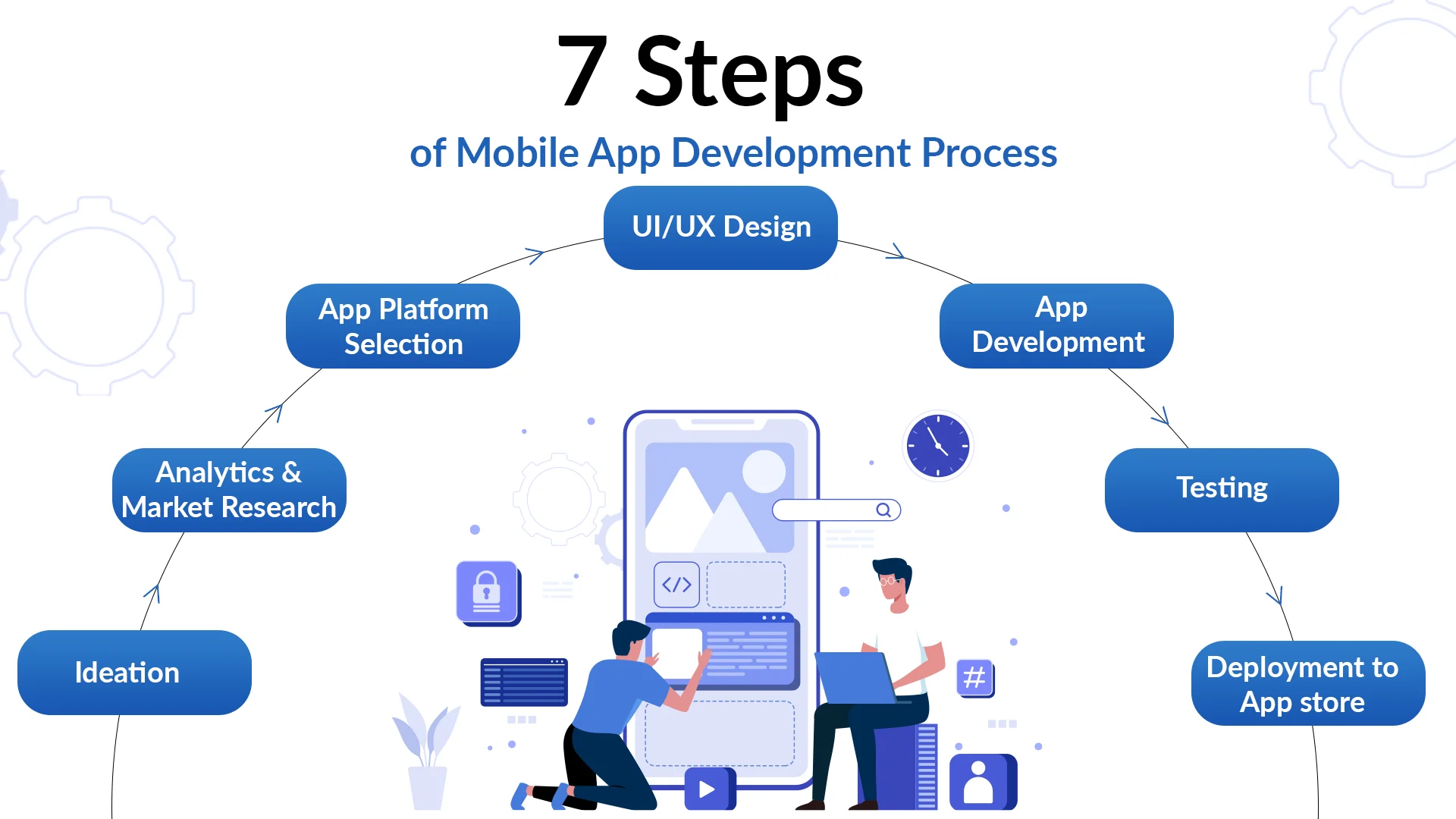
A Step-by-Step Guide for Mobile App Development
The mobile application development process steps follow a similar structure regardless of how each app differs. It continuously adapts to meet specific app requirements. Here are the methods and steps involved in developing mobile apps.
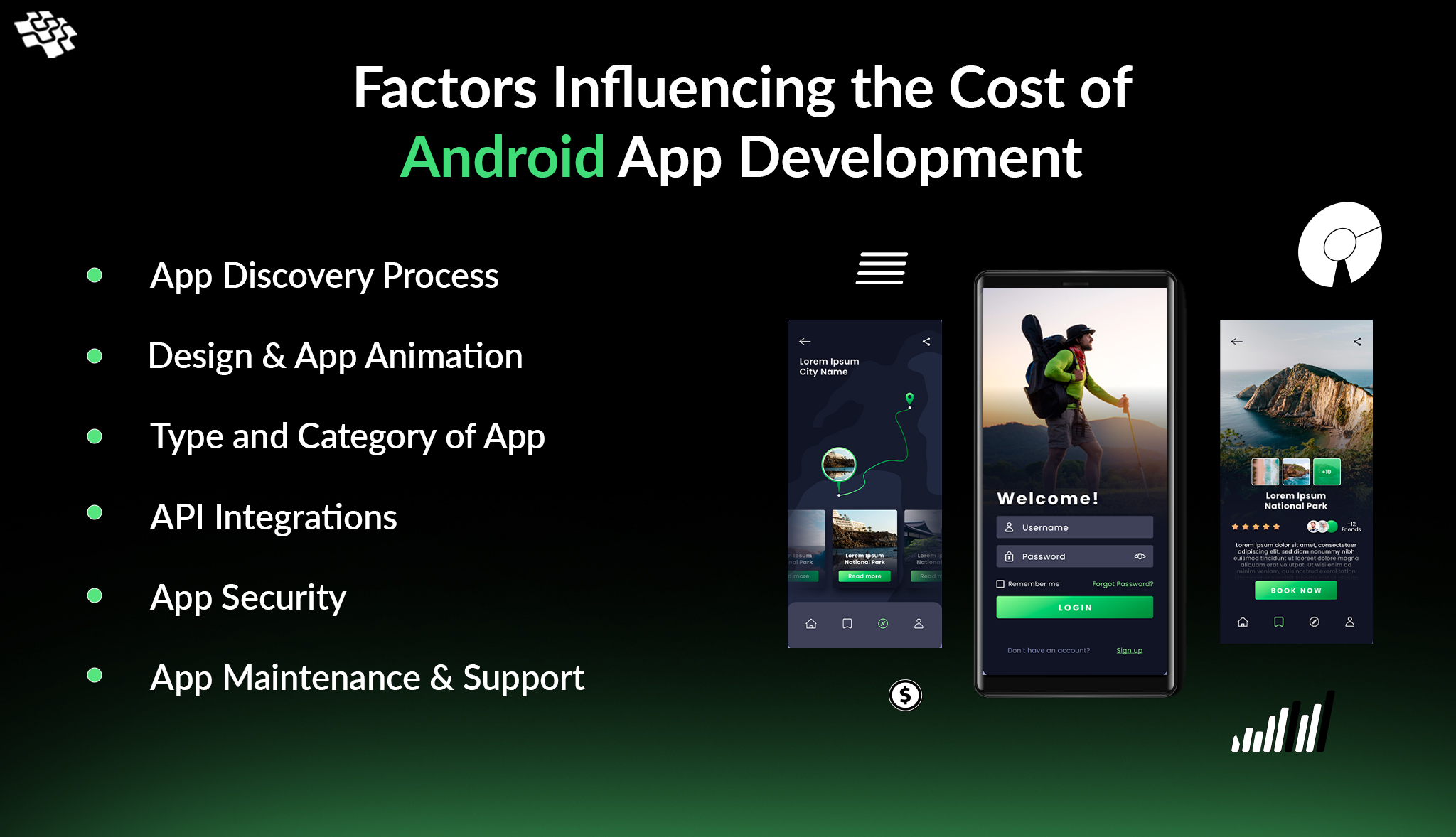
What is the Cost of Android App Development?
Factors such as developer count, app category, UI/UX designs, and app features influence the cost of hiring an Android app developer. Understanding these variables is crucial for estimating the Android app development price.
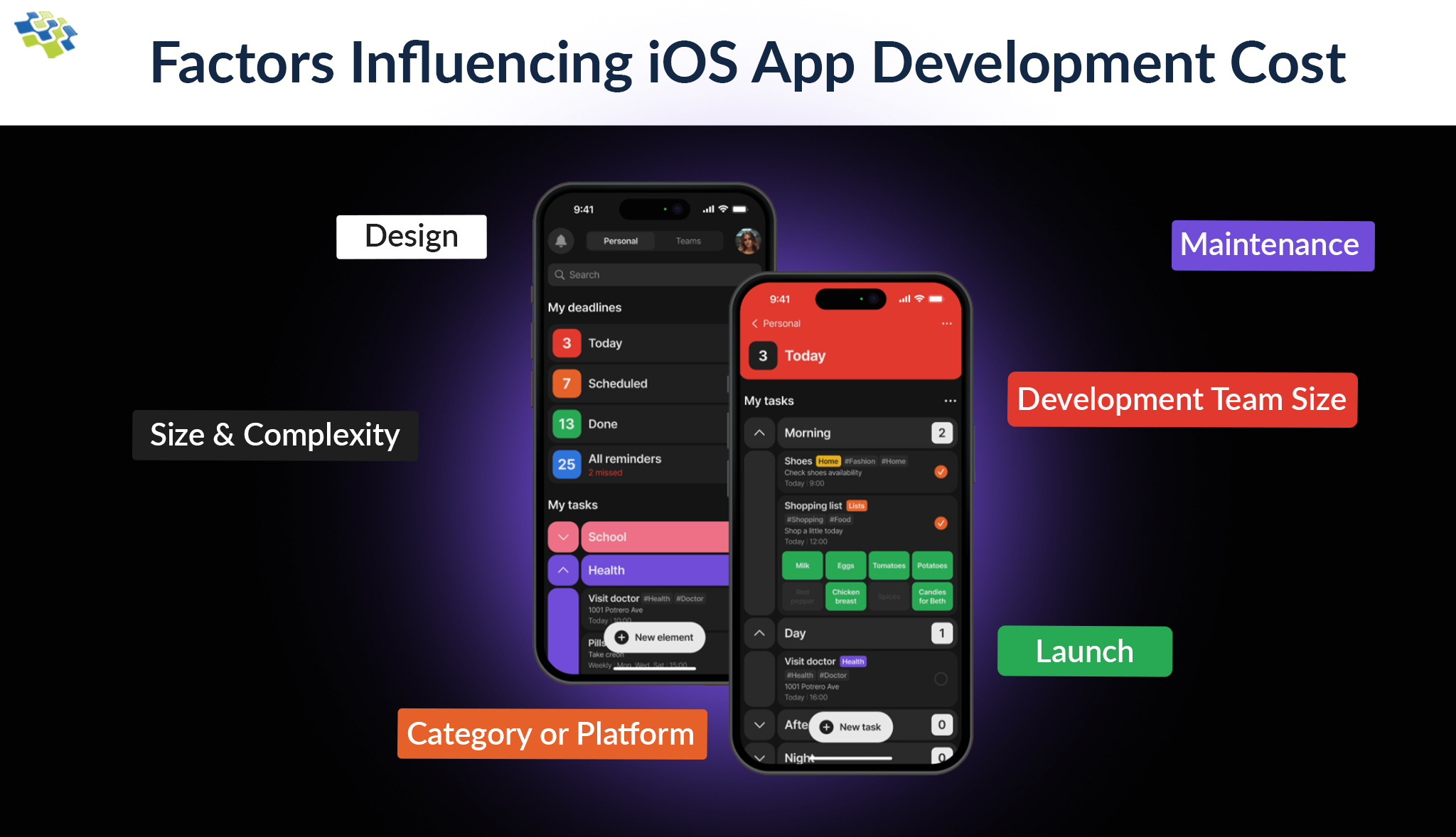
How Much Does It Cost to Develop an iOS App?
Analyzing the cost to develop an iOS app involves evaluating numerous factors from app complexity to team size. By exploring each aspect, we gain insights into how they influence overall expenses, aiding in determining precise development costs.
Stay In the Know
Get Latest updates and industry insights every month.
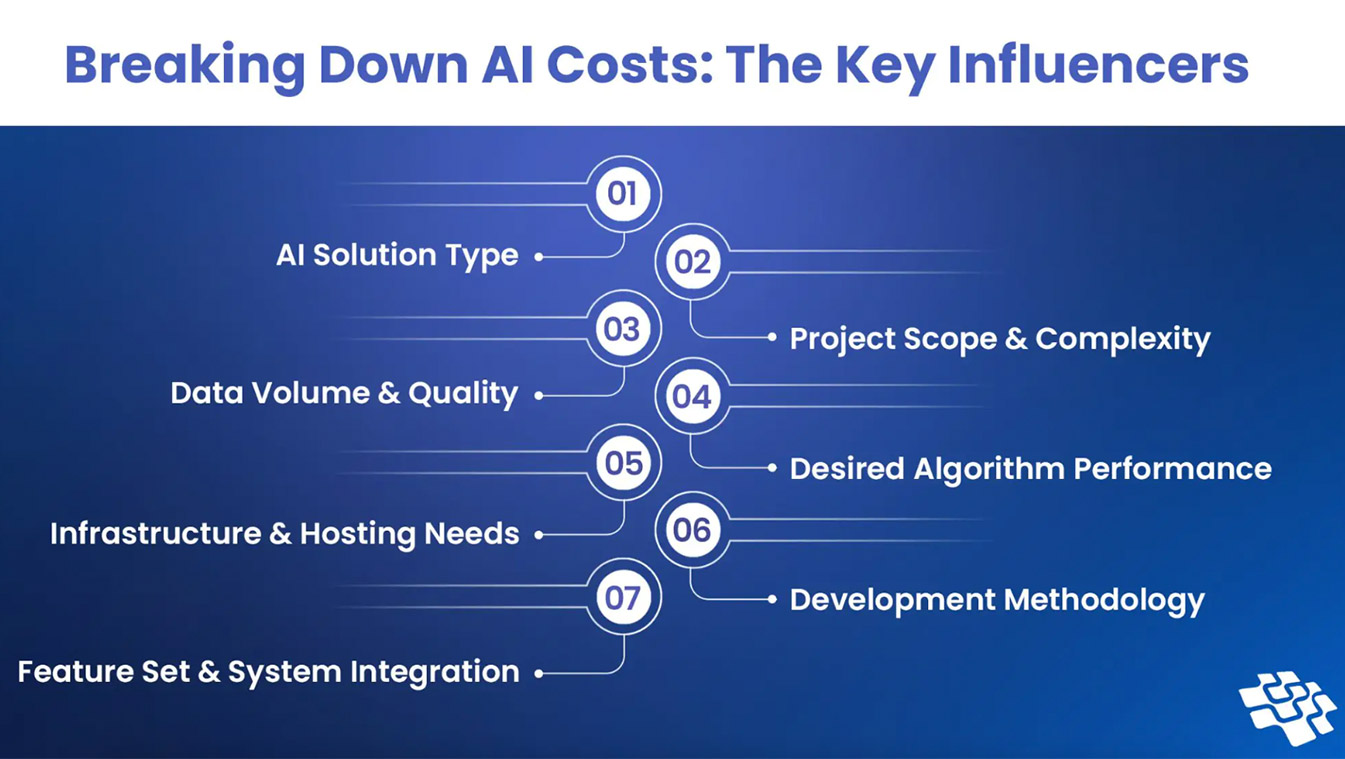 1. AI Solution Type
1. AI Solution Type